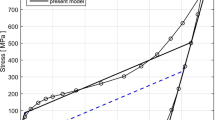Abstract
It is well known that plastic deformations in shape memory alloys stabilize the martensitic phase. Furthermore, the knowledge concerning the plastic state is crucial for a reliable sustainability analysis of construction parts. Numerical simulations serve as a tool for the realistic investigation of the complex interactions between phase transformations and plastic deformations. To account also for irreversible deformations, we expand an energy-based material model by including a non-linear isotropic hardening plasticity model. An implementation of this material model into commercial finite element programs, e.g., Abaqus, offers the opportunity to analyze entire structural components at low costs and fast computation times. Along with the theoretical derivation and expansion of the model, several simulation results for various boundary value problems are presented and interpreted for improved construction designing.






Similar content being viewed by others
References
Otsuka K, Ren X (2005) Physical metallurgy of ti-ni-based shape memory alloys. Progress Mater Sci 50(5):511–678
Otsuka K, Wayman CM (1999) Shape memory materials. Cambridge University Press, Cambridge
Shaw JA, Kyriakides S (1995) Thermomechanical aspects of niti. J Mech Phys Solids 43(8):1243–1281
Auricchio F, Reali A, Stefanelli U (2007) A three-dimensional model describing stress-induced solid phase transformation with permanent inelasticity. Int J Plast 23(2):207–226
Bartel T, Menzel A, Svendsen B (2011) Thermodynamic and relaxation-based modeling of the interaction between martensitic phase transformations and plasticity. J Mech Phys Solids 59(5):1004–1019
Bo Z, Lagoudas DC (1999) Thermomechanical modeling of polycrystalline smas under cyclic loading, part iii: evolution of plastic strains and two-way shape memory effect. Int J Eng Sci 37(9):1175–1203
Hartl DJ, Chatzigeorgiou G, Lagoudas DC (2010) Three-dimensional modeling and numerical analysis of rate-dependent irrecoverable deformation in shape memory alloys. Int J Plast 26(10):1485–1507
Reese S, Christ D (2008) Finite deformation pseudo-elasticity of shape memory alloys-constitutive modelling and finite element implementation. Int J Plast 24(3):455–482
Saint-Sulpice L, Chirani SA, Calloch S (2009) A 3d super-elastic model for shape memory alloys taking into account progressive strain under cyclic loadings. Mech Mater 41(1):12–26
Stupkiewicz S, Petryk H (2013) A robust model of pseudoelasticity in shape memory alloys. Int J Numer Methods Eng 93(7):747–769
Stebner AP, Brinson LC (2013) Explicit finite element implementation of an improved three dimensional constitutive model for shape memory alloys. Comput Methods Appl Mech Eng 257:17–35
Junker P (2014) A novel approach to representative orientation distribution functions for modeling and simulation of polycrystalline shape memory alloys. Int J Numer Methods Eng 98(11):799–818
Junker P (2014) An accurate, fast and stable material model for shape memory alloys. Smart Mater Struct 23(11):115010
Junker P, Hackl K (2016) Calibration and finite element implementation of an energy-based material model for shape memory alloys. Shape Mem Superelasticity 2(3):247–253
Junker P, Jaeger S, Kastner O, Eggeler G, Hackl K (2015) Variational prediction of the mechanical behavior of shape memory alloys based on thermal experiments. J Mech Phys Solids 80:86–102
Wang XM, Xu BX, Yue ZF (2008) Micromechanical modelling of the effect of plastic deformation on the mechanical behaviour in pseudoelastic shape memory alloys. Int J Plast 24(8):1307–1332
Hartl DJ, Lagoudas DC (2009) Constitutive modeling and structural analysis considering simultaneous phase transformation and plastic yield in shape memory alloys. Smart Mater Struct 18(10):104017
Lagoudas DC, Entchev PB, Popov P, Patoor E, Brinson LC, Gao X (2006) Shape memory alloys, part ii: modeling of polycrystals. Mech Mater 38(5):430–462
Lu ZK, Weng GJ (1998) A self-consistent model for the stress-strain behavior of shape-memory alloy polycrystals. Acta Mater 46(15):5423–5433
Yu C, Kang G, Kan Q, Song D (2013) A micromechanical constitutive model based on crystal plasticity for thermo-mechanical cyclic deformation of niti shape memory alloys. Int J Plast 44:161–191
Waimann J, Junker P, Hackl K (2017) Modeling the cyclic behavior of shape memory alloys. Shape Mem Superelasticity 3(2):124–138
Hamilton WR (1834) On a general method in dynamics; by which the study of the motions of all free systems of attracting or repelling points is reduced to the search and differentiation of one central relation, or characteristic function. Philos Trans R Soc Lond 124:247–308
Hamilton WR (1835) Second essay on a general method in dynamics. Philos Trans R Soc Lond 125:95–144
Junker P, Hackl K (2016) A discontinuous phase field approach to variational growth-based topology optimization. Struct Multidiscip Optim 54(1):81–94
Schwarz P, Junker S, Hackl K (2017) On the effect of plasticity on damage evolution using a relaxation-based material model. Under Review
Author information
Authors and Affiliations
Corresponding author
Additional information
This article is an invited paper selected from presentations at the International Conference on Shape Memory and Superelastic Technologies 2017, held May 15–19, 2017, in San Diego, California, and has been expanded from the original presentation.
Rights and permissions
About this article
Cite this article
Junker, P., Hempel, P. Numerical Study of the Plasticity-Induced Stabilization Effect on Martensitic Transformations in Shape Memory Alloys. Shap. Mem. Superelasticity 3, 422–430 (2017). https://doi.org/10.1007/s40830-017-0121-4
Published:
Issue Date:
DOI: https://doi.org/10.1007/s40830-017-0121-4



